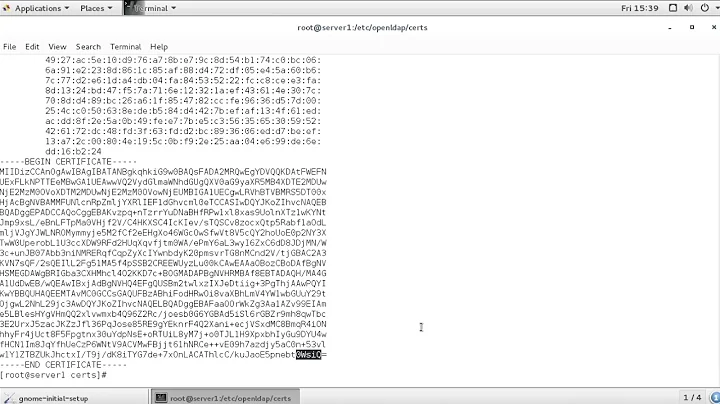Testing SSL/TLS Client Authentication with OpenSSL
Solution 1
It looks like you are trying to set up a root of trust with (1) s_client and s_server for testing; and (2) programmatically within your code using OpenSSL.
To ensure openssl s_client (or openssl s_server) uses your root, use the following options:
-
-CAfileoption to specify the root -
-certoption for the certificate to use -
-keyoption for the private key of the certificate
See the docs on s_client(1) and s_server(1) for details.
To do the same programmatically on the client, you would use:
-
SSL_CTX_load_verify_locationsto load the trusted root -
SSL_CTX_use_certificateto specify the client certificate -
SSL_CTX_use_PrivateKeyto load the private key for the client certificate
To do the same programmatically on the server, you would use:
-
SSL_CTX_load_verify_locationsto load the trusted root -
SSL_CTX_use_certificate_chain_fileto specify the server certificate -
SSL_CTX_use_PrivateKeyto load the private key for the server certificate -
SSL_CTX_set_client_CA_listto tell the client to send its client certificate
If you don't want to use the parameters for every connection (i.e. the common context), then set it for each SSL connection with, for example, SSL_use_certificate and SSL_use_PrivateKey.
A lot goes on with SSL_CTX_set_client_CA_list. It (1) loads the CA's to the server uses to verify a client, (2) it causes the server to send a list of CAs it accepts when verifing a client, and (3) it triggers the ClientCertificate message at the client if the client has a certificate that satisfies the server's accepted CAs list.
Also see the docs on SSL_CTX_load_verify_locations(3), SSL_CTX_use_certificate(3), SSL_CTX_set_client_CA_list and friends.
The easiest certificate and key format to use is PEM. PEM is the one that uses, for example, ----- BEGIN CERTIFICATE -----. For the server certificate, be sure the file is a concatenation of the server's certificate and any intermediates needed by the client to build the chain.
Having the server send all required certificates is standard practice for a problem known as the "which directory" problem. Its a well known problem in PKI, and its essentially the problem that clients don't know where to go to fetch missing intermediate certificates.
In general, you now know the functions that you need to use. Download a small server like nginx, and see how a production server uses them in practice. You could even use a SQL server like Postgres since it sets up a SSL/TLS server. Simply search the source files for SSL_CTX_load_verify_locations or SSL_load_verify_locations, and you will find the right place.
Though I don't recommend it, you could even look at s_client.c and s_server.c. They are located in <openssl dir>/apps. But the code can be difficult to read at times.
Solution 2
Generate two pairs of certificates/keys, one for the server and one for the client. Also create test.txt with any content.
To set up an SSL server that checks a client certificate, run the following command:
openssl s_server -cert server_cert.pem -key server_key.pem -WWW -port 12345 -CAfile client_cert.pem -verify_return_error -Verify 1
To test the server with client certificate, run the following command:
echo -e 'GET /test.txt HTTP/1.1\r\n\r\n' | openssl s_client -cert client_cert.pem -key client_key.pem -CAfile server_cert.pem -connect localhost:12345 -quiet
Alternatively you can use curl command:
curl -k --cert client_cert.pem --key client_key.pem https://localhost:12345/test.txt
Related videos on Youtube
fazineroso
Updated on January 23, 2021Comments
-
fazineroso over 3 years
I am developing a client/server application with TLS. My idea is to use a certificate on the client so it is authenticated by the server. Also another certificate on the server so the client is also able to authenticate that it is connecting to the right server.
I want first to test and use openssl
s_serverand openssls_clientto validate the proposal.Until now I have created a CA private key on the server, I have created a root certificate. With the root certificate I have signed two CSR, so I get one certificate for the server and one certificate for the client.
I also have installed the client certificate + root certificate on the client, and the server certificate + root certificate on the server.
I want now to try to establish a connection between openssl
s_serverand openssls_clientand verify that they get both authenticated mutually, but I cannot wrap my mind with the documentation on how to do it. Any help or any guide on that?Once I have that set up, the next step is to test the own developed client against that server, and our own developed server against the
s_client. Can we use that for testing?Thanks
-
Siu Ching Pong -Asuka Kenji- almost 6 yearsThank you so much for the answer! This answer is excellent! It makes me sad that I can't vote it up twice!
-
 Sparsh Dutta almost 3 yearsOn running the first command I am getting: [verify depth is 1, must return a certificate Enter pass phrase for server_private_key.pem: Using default temp DH parameters ACCEPT ] , The cmd is stuck at this point. Does this mean my client certificate is successfully verified? Or is this some error?
Sparsh Dutta almost 3 yearsOn running the first command I am getting: [verify depth is 1, must return a certificate Enter pass phrase for server_private_key.pem: Using default temp DH parameters ACCEPT ] , The cmd is stuck at this point. Does this mean my client certificate is successfully verified? Or is this some error? -
anton_rh almost 3 years@SparshDutta, you probably have to enter server certificate password.
-
 Sparsh Dutta almost 3 yearsI did enter server certificate password
Sparsh Dutta almost 3 yearsI did enter server certificate password -
 Sparsh Dutta almost 3 yearsIs it that I have to create a truststore and add my client certificate in server truststore?
Sparsh Dutta almost 3 yearsIs it that I have to create a truststore and add my client certificate in server truststore?





